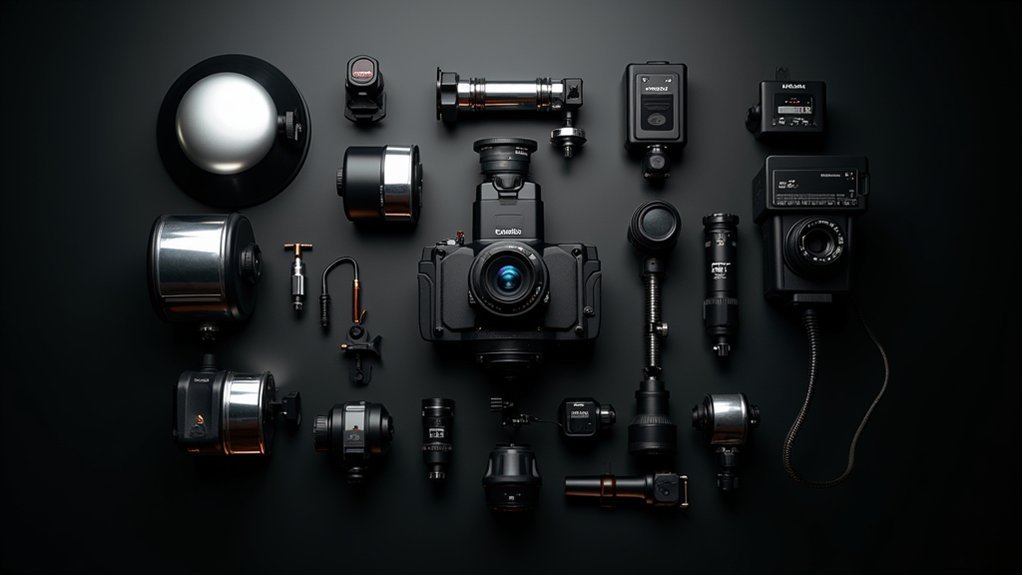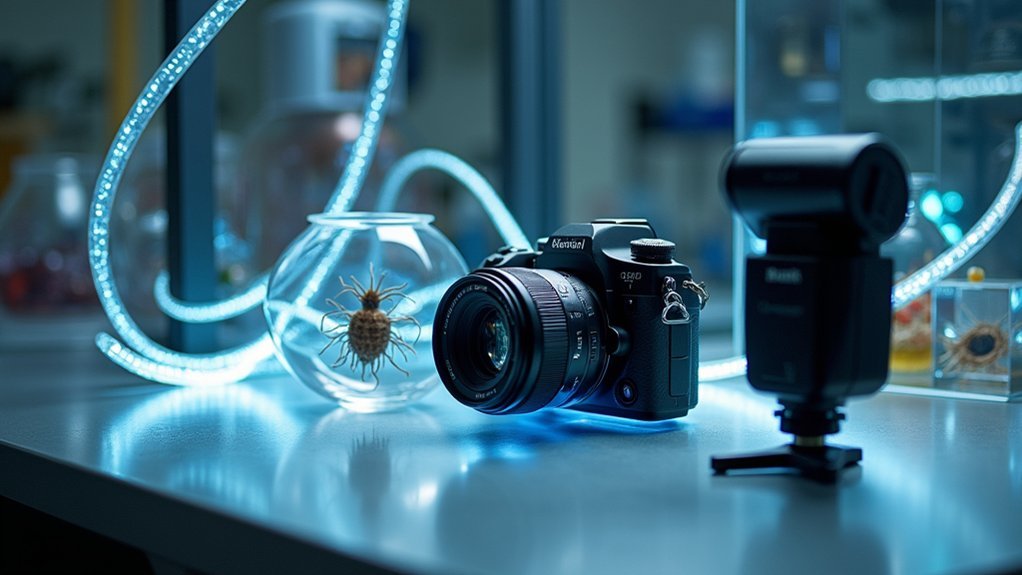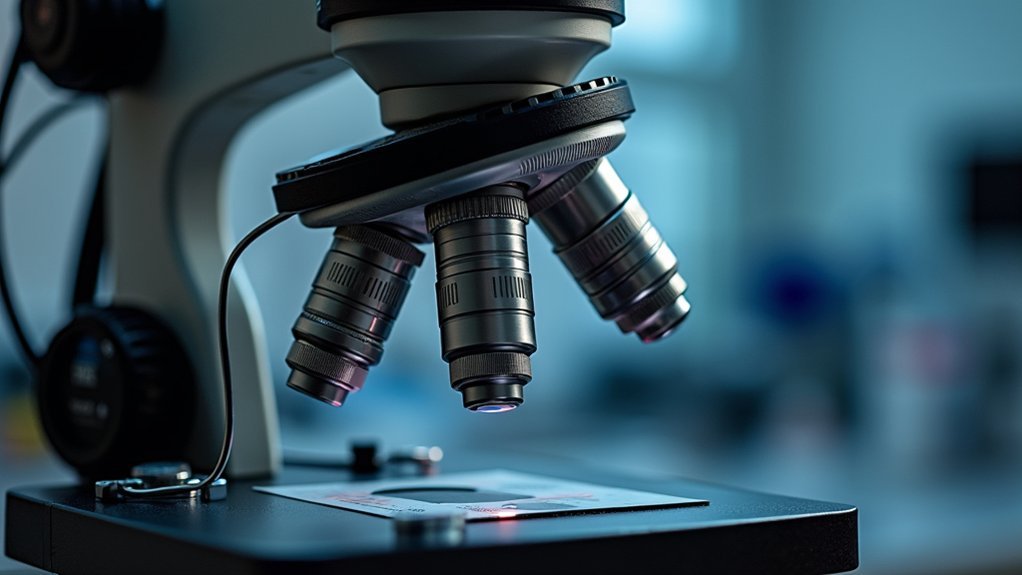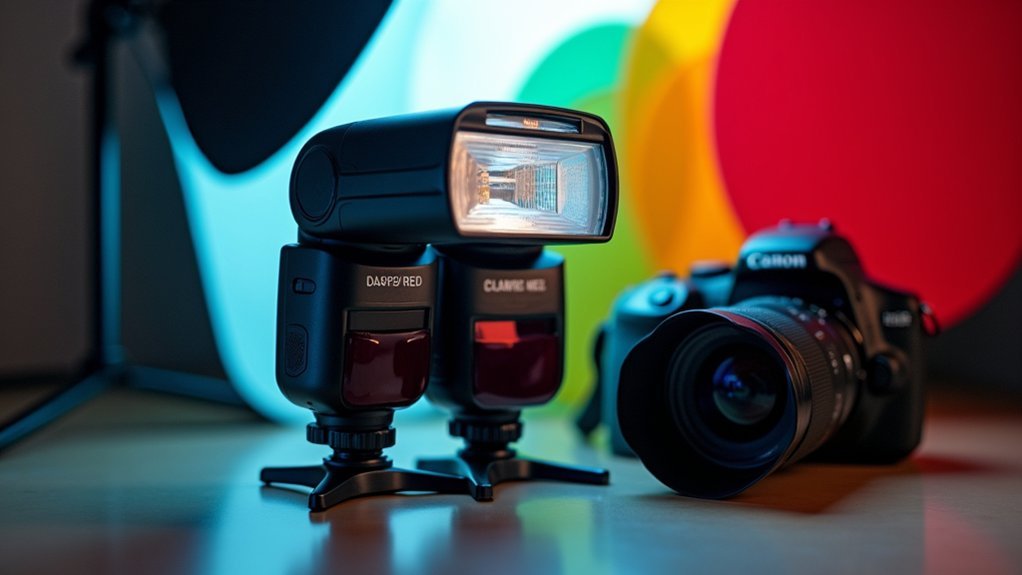For lab cameras, choose between TTL flash systems for automatic adjustments or manual control for precision. Ring flashes like Canon Macro Ring Lite provide uniform illumination, while off-camera options like Godox V850s offer directional lighting. Add fiber optic illumination for enhanced contrast and use diffusers to eliminate harsh reflections. Mount your flash with compatible brackets that won’t destabilize your microscope. Proper synchronization through dedicated triggers or sync cables guarantees your setup captures every vital detail.
Understanding Microscope Camera Flash Requirements

When capturing microscopic specimens, you’ll need specialized flash equipment that differs markedly from standard photography gear.
Microscope photography demands consistent, even illumination that minimizes shadows while highlighting minute details.
Ring flashes like the Canon Macro Ring Lite MR-14EX II offer a suitable light source for microscope work, providing uniform lighting that reveals specimen intricacies.
Ring flashes deliver the uniform illumination essential for microscopy, revealing critical details invisible under standard lighting conditions.
You’ll want to operate at lower power settings to avoid overexposure and maintain proper exposure of delicate structures.
Consider off-camera flash options such as the Godox V850s for greater positioning flexibility when ambient light conditions are challenging.
These systems allow you to direct light precisely where needed.
Confirm your chosen flash can synchronize with your microscope camera through TTL capabilities or manual settings for best results.
TTL vs. Manual Flash Control for Lab Photography
TTL flash control offers you automatic exposure adjustments that work well for rapidly changing lab scenarios, while manual flash control provides precise power settings for consistent lighting across identical specimens.
You’ll find TTL speeds up your workflow when photographing diverse samples in quick succession, eliminating the need for constant recalibration.
Your choice between these systems ultimately depends on whether you prioritize the convenience of automatic adjustments or the exactness of manually specified output levels.
TTL’s Automatic Exposure Advantage
Although laboratory photography demands consistent lighting precision, TTL flash systems offer a revolutionary advantage by automatically evaluating exposure through the camera’s lens. You’ll achieve precise control over flash output regardless of changing lighting conditions, greatly reducing underexposed images common with manual settings.
| TTL Benefits | Lab Applications | Time Savings |
|---|---|---|
| Auto adjustment | Microscopy work | No manual recalculations |
| Consistent results | Specimen documentation | Faster workflow |
| Exposure compensation | Equipment imaging | Focus on composition |
Instead of monitoring and adjusting flash power for every shot, you’ll work more efficiently with TTL. Your camera and flash communicate seamlessly, continuously evaluating the scene and adjusting output accordingly. This means you can concentrate on capturing critical details in your specimens rather than fiddling with settings between each shot.
Manual Power Precision
Despite TTL’s impressive automation capabilities, manual flash control remains essential for laboratory photography where absolute precision is required. When photographing highly reflective lab equipment or capturing minute specimen details, you’ll need complete command over your light output.
Manual flash control gives you the freedom to adjust power settings with exacting precision—ideal for consistent results across multiple shots of the same subject. Your advanced flash equipment provides the ability to fine-tune lighting ratios down to 1/128 power or less, allowing you to balance exposure perfectly with your chosen shutter speed.
While this approach demands a deeper understanding of lighting principles, the payoff is worth it. For critical lab documentation where lighting conditions remain static, investing time in manual setup guarantees the repeatable, precise results your scientific work demands.
Workflow Speed Considerations
When time constraints press against your research deadlines, choosing between TTL and manual flash control becomes a critical workflow decision. TTL systems automatically adjust to your camera’s exposure settings, allowing you to focus on composition rather than technical adjustments—particularly valuable when lighting conditions fluctuate rapidly in your lab environment.
While manual flash control offers precision for reflective surfaces and specific materials, it requires constant fine-tuning that can slow your process. TTL’s ability to maintain exposure accuracy through changing conditions markedly reduces setup time between shots.
Investing in quality equipment like the Godox V860II with TTL capability provides quick recycle times and consistent performance without complex adjustments. For labs where efficiency matters, TTL’s workflow advantages often outweigh the creative control of manual settings, especially when you’re documenting fast-paced experimental procedures.
Ring Lights and Their Applications in Microscopy
Ring lights offer you unparalleled illumination uniformity for microscopy applications, eliminating harsh shadows that often obscure critical specimen details.
You’ll find their circular design particularly valuable when examining minute structures, as they provide consistent lighting from all angles around your subject without interfering with the microscope’s optical path.
For ideal results, take advantage of adjustable brightness and color temperature settings to enhance specific features of your microscopic samples and improve image documentation quality.
Ring Light Fundamentals
Illumination quality plays an essential role in microscopy, and this is where ring lights excel. You’ll find that these circular light sources provide shadow-free illumination around your microscope lens, creating uniform light distribution that’s vital for capturing clear specimen images.
Most ring lights offer adjustable brightness settings, allowing you to fine-tune illumination based on your specimen’s sensitivity. Your lighting setup remains stable as these devices typically attach directly to the microscope without altering its configuration.
| Feature | Benefit | Application |
|---|---|---|
| Circular Design | Eliminates shadows | Detailed cell structures |
| Brightness Control | Prevents specimen damage | Delicate tissue samples |
| Direct Attachment | Maintains stability | High-magnification work |
When properly positioned, a ring light enhances details and contrast in specimens, making microscopic structures more visible and improving documentation quality for your lab research.
Microscopy Lighting Techniques
The practical application of ring lights extends beyond basic illumination into specialized microscopy techniques. When examining specimens under high magnification, you’ll find that these circular LED arrangements provide shadow-free, consistent lighting from all angles—critical for capturing detailed microscopic images.
Different types of ring lights offer adjustable brightness and color temperature settings, allowing you to customize artificial lighting conditions based on your specimen’s requirements. For transparent or reflective samples, these light modifiers reveal details that would otherwise remain hidden due to uneven illumination.
Advanced microscopy benefits from specialized ring lights with built-in diffusers that minimize glare and reflections. This feature proves particularly valuable when working with highly reflective specimens where standard lighting would create distracting highlights that obscure important structural details.
Fiber Optic Illumination Systems for Detailed Specimens

Precision lighting becomes essential when capturing microscopic details in laboratory specimens. Fiber optic illumination systems deliver exactly that, providing even lighting that minimizes shadows and enhances visibility of intricate features in your subjects.
You’ll appreciate how these systems use flexible cables to direct light precisely where needed, creating ideal lighting effects for macro photography. The ability to control highlights and shadows effectively guarantees accurate representation of your specimens.
Whether you’re using DSLR or mirrorless camera setups, these versatile systems integrate seamlessly with your existing equipment.
Fiber optic illumination systems adapt effortlessly to your photography gear, regardless of camera type or brand preference.
In low-light environments, fiber optic illumination greatly improves image quality by enhancing contrast and color accuracy. This focused approach to lighting makes these systems invaluable tools for capturing the fine details that define your research specimens.
Diffusers and Light Modifiers for Reducing Reflections
When photographing glossy lab specimens or reflective equipment, diffusers and light modifiers become essential tools in your imaging arsenal.
Softboxes and umbrellas work effectively to spread light evenly across your subjects, eliminating harsh reflections that can compromise image quality.
For best results, consider using a parabolic umbrella with a front diffuser cover, which creates remarkably soft illumination for detailed lab photography.
You can further refine your lighting setup with 5-in-1 reflectors to bounce light into shadowed areas while controlling unwanted reflections.
When working with highly reflective materials, colored gels offer creative solutions for correcting color temperature issues.
For particularly challenging specimens, a light box setup provides the most controlled environment for studio lights, ensuring your scientific imagery remains clear and professionally rendered.
Mounting Options for Flash Equipment on Lab Microscopes

Successful microscope photography requires proper flash mounting systems that accommodate the unique constraints of laboratory equipment. When setting up your flash head, verify compatibility with your microscope’s attachment points on the objective or eyepiece tube.
The Godox S2 Speedlight Bracket offers excellent flexibility for controlling light direction while maintaining stability. You’ll want to select lightweight units like the Godox V1S or V860II to prevent destabilizing your microscope setup.
Unlike traditional studio strobes and light stands that are too bulky for lab environments, these specialized brackets provide precise positioning.
Don’t forget to use modifiers such as diffusers or small softboxes to soften harsh shadows on your specimens.
Ascertain your flash equipment features adjustable TTL functionality to properly expose specimens with varying transparency and composition.
Synchronization Methods Between Microscope Cameras and Flash Units
Establishing reliable communication between your microscope camera and flash equipment represents one of the most critical aspects of successful laboratory photography.
Proper synchronization guarantees your images capture all necessary details with ideal lighting.
You’ll find several effective methods to connect your camera and flash units:
- Dedicated TTL triggers provide precise timing between your camera’s shutter and flash firing, essential for capturing microscopic specimens.
- Direct connection via your camera’s hot shoe or built-in synchronization ports offers straightforward setup for compatible flash units.
- Sync cables deliver reliable connections that minimize misfires during rapid shooting sequences.
- Wireless synchronization systems like Godox or Canon Speedlites allow flexible off-camera flash positioning for better lighting angles.
When selecting your synchronization method, consider your flash duration specifications to guarantee compatibility with your microscope camera’s shutter speed capabilities.
Frequently Asked Questions
What Is the Difference Between a Flash and a Speedlight?
A flash is any device creating bursts of light, while a speedlight is a portable, feature-rich flash that you’ll typically mount on your camera’s hot shoe or use off-camera for more creative lighting options.
Why Is Flash Photography Not Allowed?
Flash photography is often banned because it can damage sensitive artworks, interfere with medical procedures, temporarily blind people, disturb wildlife, or disrupt events. You’ll find these restrictions in museums, hospitals, and natural settings.
Are Camera Flashes Brand Specific?
Yes, camera flashes are typically brand specific. You’ll get the best functionality when using flashes designed for your camera brand, though third-party options exist that offer cross-compatibility with some potential feature limitations.
What Do I Need for Flash Photography?
For flash photography, you’ll need a compatible flash unit, triggers for off-camera use, light modifiers like umbrellas or softboxes, sturdy light stands, and fresh batteries. Don’t forget to master your camera’s exposure settings too.
In Summary
When choosing flash equipment for your lab camera, you’ll need to match the specific requirements of your microscopy work. Whether you opt for TTL or manual flash, ring lights or fiber optic systems, make certain proper synchronization with your camera. Don’t forget diffusers to minimize reflections. The right mounting solution will keep your setup stable and functional. Your perfect flash configuration will dramatically improve your specimen documentation quality.





Leave a Reply